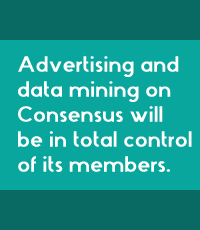The Low Ring
The low ring will be composed of 200 members who are selected in a plurality vote (i.e. the 200 members who have the most votes get the position). In this process, the voting members have—through their own unique eyes, ears, and perspectives—selected 200 very capable members for the low ring. Because of their involvement in Consensus, each of these 200 members has shown some capacity to serve in Consensus.
There will be low ring members who anticipated the possibility of their election and really want to serve. Their involvement in the low ring in the next year will prove their actual abilities.
Other low ring members will be surprised that enough Consensus members thought so highly of them. Some will welcome the challenge and contribute to the governance of Consensus. Others will have preferred not to have been elected to the low ring: they need only remain inactive in their low ring committee work to not be elected in the next low ring election.
When elected, each low ring member can choose to serve on two committees of their interest:
- Accounting
- Finance
- Advertising
- Other Revenue
- Data Mining
- Security
- Privacy
- Discussion Groups
- Management Company
- Legal
- Governance
- Rules
- Research & Development
- Software
- Philanthropy
- Committees
- Long term strategy
I anticipate that 100 low ring members will be active in serving Consensus. If each active member serves on two committees, then the average committee would have 12 members. Hopefully each committee will have at least one member from all the other committees. In this way, each committee would have some institutional knowledge of all parts of Consensus.
These 17 committees are not fixed. Some may be amalgamated; some may be split; some may be disbanded; new committees may be formed. The High Ring will make these changes as needed, getting advice from the “Committees” committee.
There will be some kind of online forum where the low ring members can participate in discussion of their committee. Most of this discussion should be transparent in that any Consensus member can view the low ring discussion but is not allowed to comment. However, there should be a parallel online forum where members can participate freely on these same topics.
There will be an online process for the low ring committees to reach a decision. When low ring members seem to be reaching consensus, one low ring member can initiate a formal motion. The member will draft the motion and post it to the committee. If the motion gets 20% support, then it should move into a formal discussion of 14 days and then put to a vote. To demonstrate consensus, a vote greater than 50% should be required for the motion to pass.
If further discussion refines the motion, the motion should be withdrawn and resubmitted.
If the motion is passed by the committee, it is passed to the high ring for serious consideration. Please understand that this low ring directive is only advisory in nature. The high ring has a better “big picture” to make the best decisions.
I believe that only individual profiles can be voted to serve to serve in the low ring. However, profiles of a more corporate nature can still vote for individual profiles into the low ring. Many of these and similar details will require vetting from the Project Manager and her advisors.




